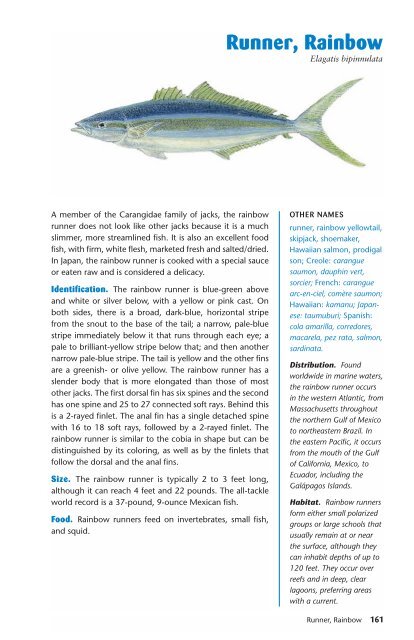Ken Schultz's Field Guide to Saltwater Fish - Macaw Pets store
Ken Schultz's Field Guide to Saltwater Fish - Macaw Pets store
Ken Schultz's Field Guide to Saltwater Fish - Macaw Pets store
Create successful ePaper yourself
Turn your PDF publications into a flip-book with our unique Google optimized e-Paper software.
A member of the Carangidae family of jacks, the rainbow<br />
runner does not look like other jacks because it is a much<br />
slimmer, more streamlined fish. It is also an excellent food<br />
fish, with firm, white flesh, marketed fresh and salted/dried.<br />
In Japan, the rainbow runner is cooked with a special sauce<br />
or eaten raw and is considered a delicacy.<br />
Identification. The rainbow runner is blue-green above<br />
and white or silver below, with a yellow or pink cast. On<br />
both sides, there is a broad, dark-blue, horizontal stripe<br />
from the snout <strong>to</strong> the base of the tail; a narrow, pale-blue<br />
stripe immediately below it that runs through each eye; a<br />
pale <strong>to</strong> brilliant-yellow stripe below that; and then another<br />
narrow pale-blue stripe. The tail is yellow and the other fins<br />
are a greenish- or olive yellow. The rainbow runner has a<br />
slender body that is more elongated than those of most<br />
other jacks. The first dorsal fin has six spines and the second<br />
has one spine and 25 <strong>to</strong> 27 connected soft rays. Behind this<br />
is a 2-rayed finlet. The anal fin has a single detached spine<br />
with 16 <strong>to</strong> 18 soft rays, followed by a 2-rayed finlet. The<br />
rainbow runner is similar <strong>to</strong> the cobia in shape but can be<br />
distinguished by its coloring, as well as by the finlets that<br />
follow the dorsal and the anal fins.<br />
Size. The rainbow runner is typically 2 <strong>to</strong> 3 feet long,<br />
although it can reach 4 feet and 22 pounds. The all-tackle<br />
world record is a 37-pound, 9-ounce Mexican fish.<br />
Food. Rainbow runners feed on invertebrates, small fish,<br />
and squid.<br />
Runner, Rainbow<br />
Elagatis bipinnulata<br />
OTHER NAMES<br />
runner, rainbow yellowtail,<br />
skipjack, shoemaker,<br />
Hawaiian salmon, prodigal<br />
son; Creole: carangue<br />
saumon, dauphin vert,<br />
sorcier; French: carangue<br />
arc-en-ciel, comère saumon;<br />
Hawaiian: kamanu; Japanese:<br />
taumuburi; Spanish:<br />
cola amarilla, corredores,<br />
macarela, pez rata, salmon,<br />
sardinata.<br />
Distribution. Found<br />
worldwide in marine waters,<br />
the rainbow runner occurs<br />
in the western Atlantic, from<br />
Massachusetts throughout<br />
the northern Gulf of Mexico<br />
<strong>to</strong> northeastern Brazil. In<br />
the eastern Pacific, it occurs<br />
from the mouth of the Gulf<br />
of California, Mexico, <strong>to</strong><br />
Ecuador, including the<br />
Galápagos Islands.<br />
Habitat. Rainbow runners<br />
form either small polarized<br />
groups or large schools that<br />
usually remain at or near<br />
the surface, although they<br />
can inhabit depths of up <strong>to</strong><br />
120 feet. They occur over<br />
reefs and in deep, clear<br />
lagoons, preferring areas<br />
with a current.<br />
Runner, Rainbow 161


